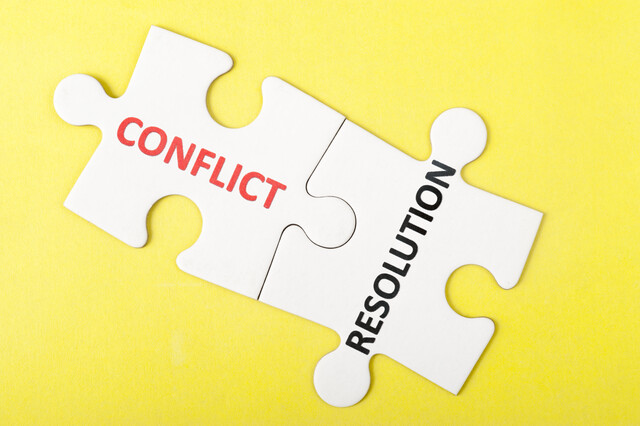Decision Making: Process, Techniques, and Finalizing the Choice
Process: In their extraordinary book on decision making Think Again: Why Good Leaders Make Bad Decisions and How To Keep It From Happening to You (2008), authors and business professors Sydney Finkelstein, Jo Whitehead, and Andrew Campbell describe the standard model for the decision-making process. They state, "There are plenty of books and articles about how people ought to make decisions. Most of them suggest something along the following lines:
-
Lay out the problem.
-
Define the objectives.
-
Generate options.
-
Evaluate each option against the objectives and other relevant criteria.
-
Choose the option with the best outcome.
-
Monitor progress, and change course if necessary." [italics added]
This is an excellent summary of an effective decision-making process applicable to the widest variety of circumstances. The first three steps are largely a restatement of the problem solving covered earlier in the course.
Once the problem is well defined and alternative solutions proposed, the whole decision-making process seems to boil down to step five: "Choose the option with the best outcome." Of course. This is common sense.
However, as Finkelstein, Whitehead, and Campbell point out so convincingly in their work, our brains don't always cooperate in making the best choices, and there is always uncertainty about outcomes in the unpredictable future. No one wants to make a bad or poor or disastrous decision, and yet intelligent, experienced, competent, and well-intentioned individuals make such decisions constantly.
These three experts assert that since decisions so often go wrong, there must be something special going on that interferes with optimal thinking. Their research traced bad decisions to show how the brain works in the decision-making process.
Finkelstein, Whitehead, and Campbell focused on pattern recognition and emotional tagging to explain how the brain functions in decision making. Simply put, when someone is faced with a decision, one looks at other situations that appear similar and therefore suggest a pattern. Then, one can make a decision based on what worked and didn't work in a matching situation. This is very effective as far as it goes.
The second component of the Finkelstein, Whitehead, and Campbell model involves emotional tagging. Emotions are important in decision making because they have been hardwired through human evolution as necessary for survival. "We need the ability to make decisions and act without the intervention of reason." This is how a human being survives in emergency situations when there is no time to think.
Emotional tagging is inevitable in part because it is mostly unconscious. What the decision maker needs to be aware of is that even apparently rational thinking is highly influenced by the emotions (and intuition/instinct) attached to it.
Clearly the challenges in the decision-making process, as outlined by Finkelstein, Whitehead, and Campbell, occur in how one implements key actions in the process. A good or bad decision depends on the principles: "evaluate each option," "choose the best outcome," and "change course, if necessary."
Evaluate the Options: In many instances (but certainly not all), one can reasonably use the method of pattern recognition to determine the most probable impacts and consequences of certain kinds of decisions. If it is a relatively straightforward question of profit and loss, there are many standard methods, models, and software programs that one can use to evaluate an investment.
Jeremy Vohwinkle is an investor, financial planner, and retirement planning specialist. Vohwinkle is also the author of the popular personal finance blog at Generation X Finance. In an article on Financial Planning for the website About.com, Vohwinkle covered a very common example of an investment decision. How does one evaluate a decision to put money into renovating or improving one's home, based on the net affect on the home's resale value?
Vohwinkle gives advice on how to make a bad decision, "One of the most popular home improvements is finishing a basement... But, did you know that finishing a basement is often one of the lowest returning home improvements? In many cases, you'll only receive about 50 percent of what you put into the cost of the project when it comes time to sell."
And how to make a good one, "On the other hand, two of the best improvements you can make to your home come from remodeling kitchens and baths... In many cases, you can expect to receive about 75 to 90 percent of the cost of updating one of these rooms."
In this example, evaluating the options seems perfectly simple: 50 percent recovery of the investment in finishing a basement suggests a poor choice. A recovery rate of 70 to 90 percent on adding a bathroom or improving a kitchen indicates a very good choice.
Referring back to the Finkelstein, Whitehead, and Campbell model, however, one can see where emotions may get in the way of one's evaluation of options. The owner of the home may feel that the most valuable use of his space is having family and friends together to enjoy shared activities. This would include, for example, watching the Super Bowl or streaming a family friendly movie on Netflix, or playing wii tennis with his wife. He wants to finish his basement to create an entertainment center where these desirable activities take place on a regular basis. He is emotionally attached to a "bad" financial decision, one that he may regret when he has to relocate for his job and sell the house. But experts like Finkelstein, Whitehead, and Campbell would predict that this homeowner is much more likely to make an emotion-based decision than a more logical pattern-based decision. That's just the way the human brain works in real life.
Choose the Best Outcome: Hans Greimel, @hansgreimel, who writes from Tokyo, Japan, is Automotive News Asia Editor covering Japanese automakers and suppliers.
About a generation ago, the management leaders of the highly successful Japanese automakers, such as Toyota, Honda, and Nissan, had to decide between two clear options with very different outcomes. Option one was to continue business as usual with cars being manufactured in Japan and shipped to foreign markets, the most important being, of course, the American market. The obvious outcome of this strategy would be protecting Japanese jobs in Japan and benefiting the Japanese economy in a direct way through a strong export economy and positive balance of trade.
Option two meant recognizing the importance of the American market and sacrificing Japanese jobs to continue strong growth and profitability. In this case, Honda took the lead in implementing option two. The first U.S. plant for manufacturing Japanese brand vehicles was opened by Honda in 1982.
According to Greimel, this choice "began as a political imperative. Three decades ago, Japan's car makers begrudgingly started building factories there, pushed by international trade politics and the voluntary export restraints that resulted." American workers were protesting unfair trade practices and getting lots of support from the public and from politicians.
It also turned out to be a great business decision. For these automakers and other Japanese companies that followed their lead, the outcomes have been very positive. Among the Forbes 100 list of top global corporations, Toyota is the only automaker in the top 10, and Honda and Nissan place in the top 50 most successful (based on total revenue) companies in the world.
Greimel also sees a very positive "unintended consequence" of the Japanese companies' decisions: "Japan's automakers now see a need to build, design and engineer cars in the markets in which they are sold. Toyota's recall crisis of 2009 and 2010 underscored for everyone the risk of having big markets isolated from engineers and decision makers. Local input also generates products that relate better to the needs of potential customers." So, the good choices from 30 years ago will continue to produce positive outcomes in the future.
Change Course if Necessary: For example, a company has developed a new product and is ready to bring it to market. Management needs to make key decisions about manufacturing, marketing, pricing, distribution, etc. The most direct approach is to look at other products offered by the company and others, and analyze where product launches succeeded or failed.
It may be that one product appeared to be successful because of the way it was marketed. There are, for example, many great instances of value marketing. Marketing Volvo automobiles and Michelin tires as enhancing the safety of families and children has been a highly effective marketing strategy for those brands.
A hypothetical company has been developing a jogging stroller. Its engineers and designers have focused on top-notch materials, quality control in manufacturing, ease of use, reliability, and durability and longevity. But the marketing department, seeing a pattern from other brands, wants to focus on a value-driven campaign. "At BabyGo Corp, we care. We care about the comfort and safety of your child. We care about the health and fitness of the child's mother and father. The BabyGo 2000 is a big hug for the whole family."
This campaign makes perfect sense, unless ... There is a recession, and families become concerned with one thing only: PRICE. No one wants to buy the BabyGo 2000, because Walmart is selling a jogging stroller brand that sells for 20 percent less. What appeared to be a perfectly good, "logical" decision based on pattern recognition turns out to be a bad decision because of new conditions in the marketplace.
It becomes necessary for BabyGo to "change course." Marketing the new product requires an entirely different message to consumers: "At BabyGo, we understand that every family needs to be careful in tough times. When you're watching every penny, look to the BabyGo 2000. It offers your family the best value for the money." Recognizing a new pattern yields a change in course, which equals success.
These three steps serve as a good summary of the decision-making process: 1) Evaluate each option against the objectives and other relevant criteria; 2) Choose the option with the best outcome; 3) Monitor progress, and change course,, if necessary.
Techniques: There are any number of ways to evaluate and choose among options. A few basic principles apply. The first, and most obvious, is to narrow down the list of choices to a manageable number.
One effective way to do that is to establish a list of criteria. Any option worth considering must fulfill the criteria, preferably all the criteria. Business decisions are often of this type. The list may include, for example, costs, available financing, available personnel within the company and recruits, competition, market niche, public relations, stock price, culture, mission, and strategy.
Any major decision, such as introducing a new product, entering a foreign market, agreeing to a merger, would benefit from having a very clear list of criteria. We can afford $X-million for this effort. We can finance it through a combination of an SBA loan, bank financing, and bonds. We can recruit the personnel we need by paying hiring bonuses of $Y-thousand. And so on. So, the new product, expansion, or merger gets the green light.
The opposite approach also works. Instead of an alternative fulfilling a list of criteria in order to be chosen, the alternative only has to fail one criterion in order to be rejected. Examples abound: When choosing a hotel room, most travelers will reject a smoking room regardless of any other criteria, such as price or convenient location or free WiFi.
The simplest application of the Finkelstein, Whitehead, and Campbell's pattern perspective is to decide based on previous decisions that worked out. This can be summed up as, "When this happens, do that." In organizations and businesses such decision making often boils down to policies expressed as rules and guidelines. A rule is a specific requirement that must be followed at all times, while a guideline is a principle of action that may be adjusted to a given set of circumstances.
Outside influences may lead to pressure to make decisions that conform to what others do in your industry, or in your geographical region. This is the, "Don't make waves" approach that may appeal to Boards of Directors in both the profit and non-profit spheres.
Or one may do exactly the opposite and rebel, playing the devil's advocate in decision making. Peter Lewis, founder of Progressive Insurance, made his fortune by playing devil's advocate in the vehicle insurance business. When he began Progressive, most companies would not insure motorcycle riders because of a perception of extreme risk. Lewis realized he could insure motorcycle riders and charge them higher premiums that would more than compensate for what was, in reality, not much higher risk than insuring auto drivers. His rebellion against the crowd is one of the most notable examples of a good business decision in a generation.
The final option is to stay with the status quo. Indeed, making no decision is really a decision. And, of course, it is much more common than one imagines. Every time the Federal Reserve makes a decision not to change interest rates, the no-decision has a powerful impact on the economy. In this case, the no-decision is often a very major decision.
The Bottom Line Is Responsibility: According to Professor Robert Harris, "There are two major approaches to decision making in an organization -- the authoritarian method, in which an executive figure makes a decision for the group, and the group method, in which the group decides what to do."
In the authoritarian approach, no surprise, the manager makes the decision, explains the decision to his or her subordinates, and seeks their acceptance of it. This method is often appropriate in a situation where there is a clear chain of command.
An extreme version would be what takes place in an airport control tower. This is not the place for discussions and different points of view. If there is a situation with, for example, two airplanes arriving at the same time and trying to use the same runway to land, whoever is the officer on deck must decide which plane to clear for landing and which to divert. He or she tells the controllers what to do and explains very briefly why plane A can land, and plane B has to circle and wait.
According Harris, such executive decisions are "based on the knowledge he [the manager] can gather." This approach, therefore, assumes some preparation in the form of doing research on the problem and collecting data from others, often in the form of memos, reports, briefings, and real-time computer data.
In the airport example, the knowledge needed for a rapid decision would come from flight plans, radar tracking, weather conditions, the fuel capacity of the aircraft-- all of which would be readily available through the airport's computer systems.
When decisions can be made outside an emergency atmosphere, there is still room for the authoritarian approach, but it requires buy-in from subordinates. Indeed, Harris explains, "In some studies, the time breakdown for a typical [authoritarian] operating decision is something like this: make decision, 5 min.; explain decision, 30 min.; gain acceptance, 30 min." Much more time and effort goes into promoting action on the decision than in making the decision in the first place.
Harris strongly favors group decisions over authoritarian ones. He explains, "The group shares ideas and analyses, and agrees upon a decision to implement. Studies show that the group often has values, feelings, and reactions quite different from those the manager supposes they have. No one knows the group and its tastes and preferences as well as the group itself. And, interestingly, the time breakdown is something like this: group makes decision, 30 min.; explain decision, 0 min.; gain acceptance, 0 min. Clearly, just from an efficiency standpoint, group decision making is better. More than this, it has been shown many times that people prefer to implement the ideas they, themselves, think of. They will work harder and more energetically to implement their own idea than they would to implement an idea imposed on them by others."
Assuming, then, that one's organization is following the group decision-making model, the above description indicates what steps need to be taken: 1) share ideas, 2) analyze the ideas, and 3) reach agreement on a decision to be implemented.
For sharing ideas, Harris recommends free discussion in which "the problem is simply put on the table for the group to talk about." For example, in the 1990s, Merrill Lynch maintained its headquarters in New York City, where construction costs, real estate prices, and taxes were very high. Management could have made an authoritarian decision to relocate. But they needed to know what the consequences would be, including how many skilled and experienced employees they would lose in a move. So, they engaged in a group-decision process.
The problem on the table was moving the company's headquarters and workplace to suburban New Jersey. How did the employees feel about such a move? Did it appear to be a good or bad idea, and why?
Analyze ideas: The other kind of group decision making is developmental discussion, or structured discussion. This is where analysis comes in. The problem is broken down into steps, smaller parts with specific goals.
In the Merrill Lynch example, the developmental style discussion focused on the goal of losing the least number of valuable employees. So, the group discussed: What will be the deciding factors in each person's decision to move with the company or resign? What incentives will the company offer for those who move? What severance packages will be offered to those who do resign? What are the real estate prices for homes near the proposed new location? Will there be any financing offered by the company to buy a new home in the area? What is the quality of public schools in the area? How much access is there to shopping, churches, restaurants and entertainment, parks and recreational facilities?
In Harris's opinion, such "Developmental discussion (a) insures systematic coverage of a topic and (b) insures that all members of the group are talking about the same aspect of the problem at the same time."
The final, and most important, step is to "reach agreement on a decision to implement." This assumes that one has now determined viable alternatives from which to choose. But how to choose?
Professor Harris offers guidance through four decision strategies that can be applied to simple or complex problems. These include: 1) Optimizing. "This is the strategy of choosing the best possible solution to the problem, discovering as many alternatives as possible, and choosing the very best;" 2) Satisficing [satisfactory plus sufficient]. "In this strategy, the first satisfactory alternative is chosen rather than the best alternative;" 3) Maximax. "This stands for "maximize the maximums." This [optimistic] strategy focuses on evaluating, and then choosing, the alternatives based on their maximum possible payoff;" and 4) Maximin. "This stands for 'maximize the minimums.' In this strategy, that of the pessimist, the worst possible outcome of each decision is considered and the decision with the highest minimum is chosen."
Most people faced with a decision -- major or minor -- would only consider "optimizing." After all doesn't one always want the best possible solution? Certainly. Unless there are factors such as cost, time limitations, available human resources, personal values, company mission, or other factors that suggest or demand an alternative path -- because a "good decision" isn't going to be much good if it can't be implemented.
Examples of Harris's alternatives to optimizing come up all the time. You are a singer preparing for a concert. The uniform for the whole chorus is white top, black pants or skirt. You go into a department store and pick the first white shirt you see within your price range. You don't take the time to examine the fabric content, washing instructions, country of origin, and so on of every white shirt in the store. "Satisficing" works just fine: you have your white shirt, and it only took 10 minutes to select it.
There are three seconds left in a playoff basketball game. The score is tied. Your team will pass in the ball from underneath the opponents' basket at the opposite end of the court. As the coach, you must choose the play. Long pass and shoot, or dribble down the court and shoot? You happen to have Michael Jordan on your team. It's pretty easy to choose to "maximax" with the dribble and shoot option, since once Jordan has the ball he is very likely to find a way to make the winning shot.
In another example drawn from sports, golfers often choose to "maximin." A pro player is 150 yards from the green. There are sand traps on both sides of the green. The greens are dry and hard and very fast, so hitting a shot that lands on the green may cause the ball to roll all the way off the green. A maximin choice here is to hit a shot that will land short of the green and, perhaps, roll onto the front of the green. Such a shot will leave a chip or a long putt, but it is the best of the bad options since it avoids landing in a sand trap or rolling the ball off the back of the green. The tournament winner may well choose the "maximin" route in this case, take his par, and go for birdie (maximax) on the next hole.
Thus, optimizing is not always the best strategy. And wise decision makers will very often go a different route.































